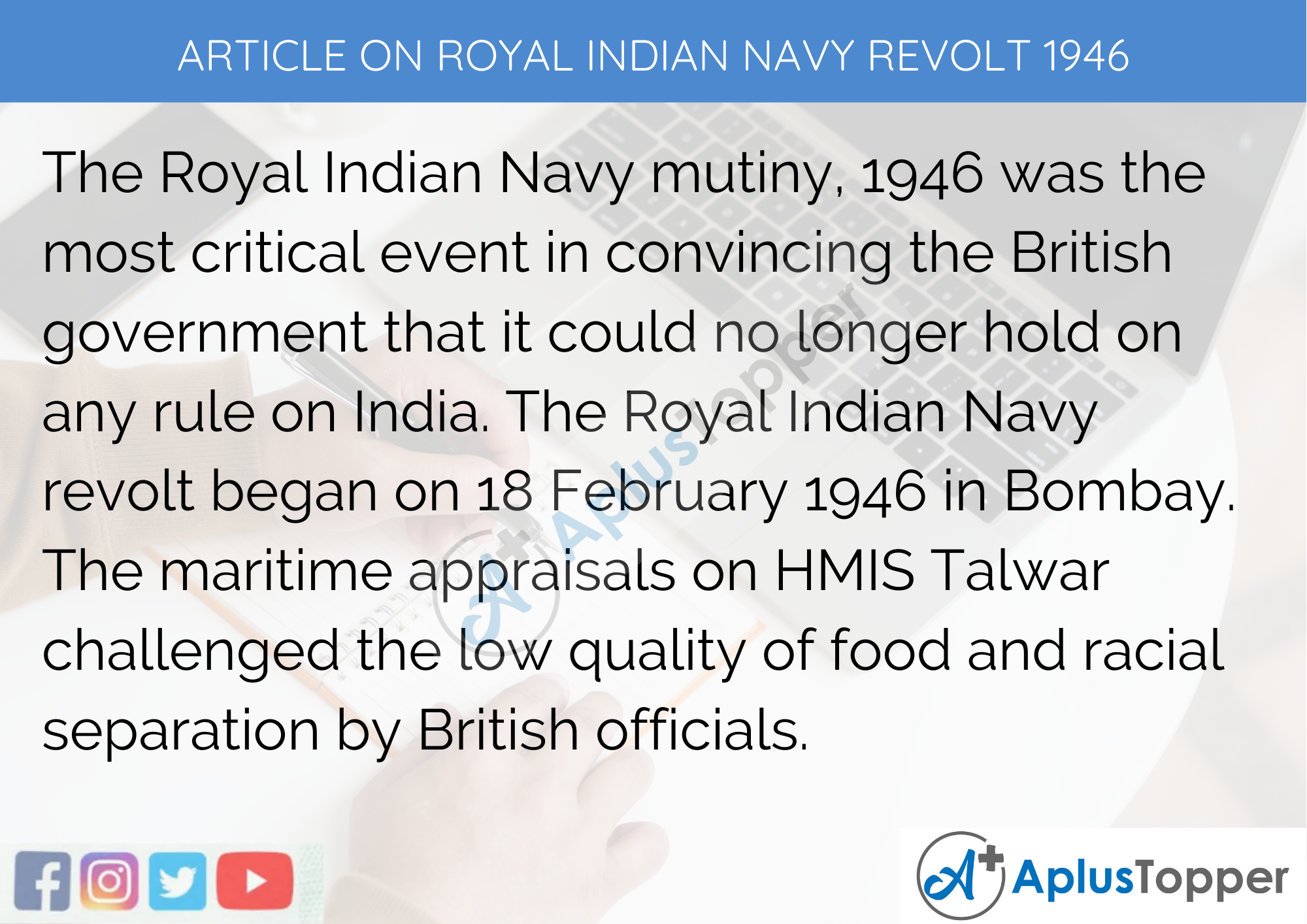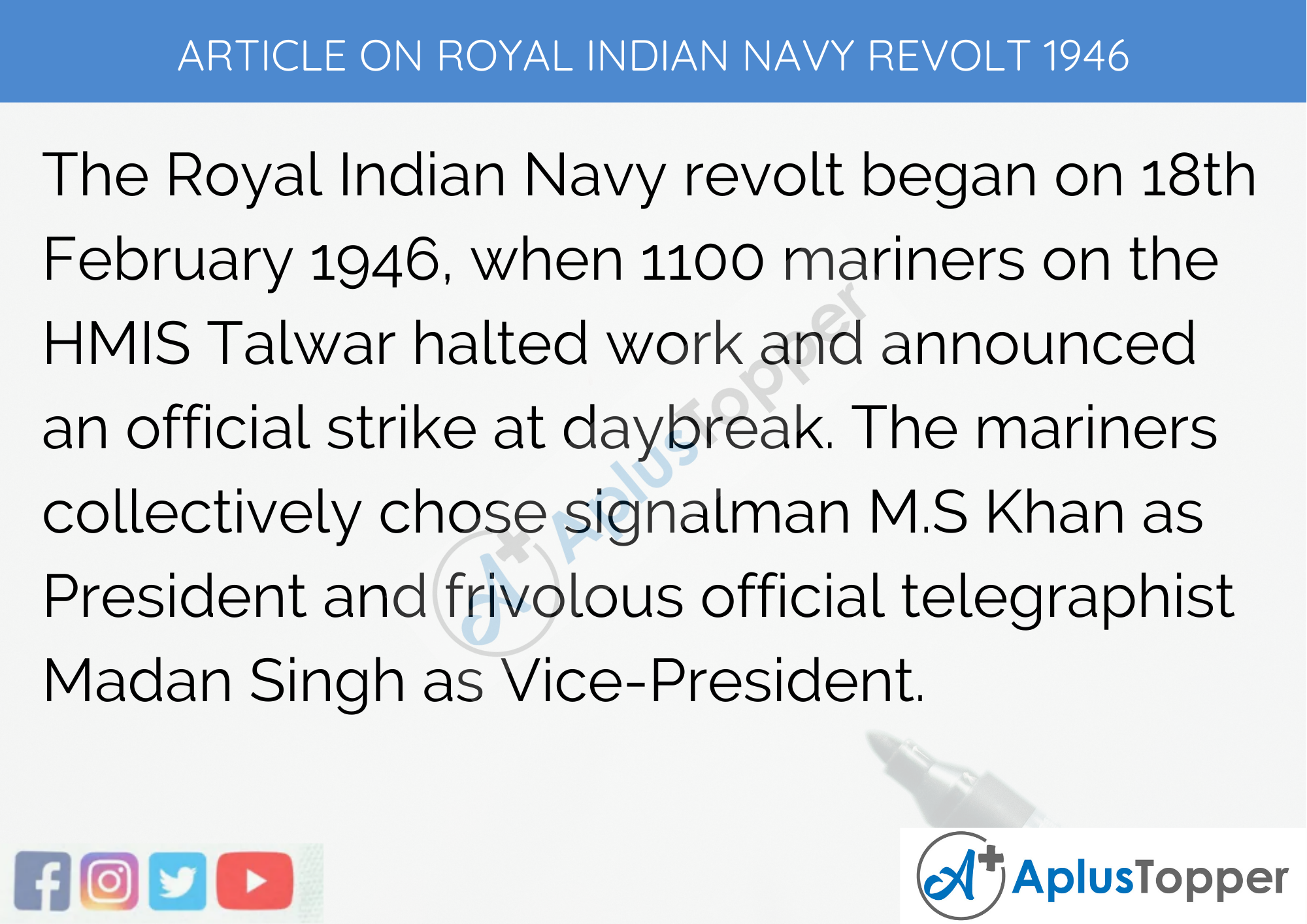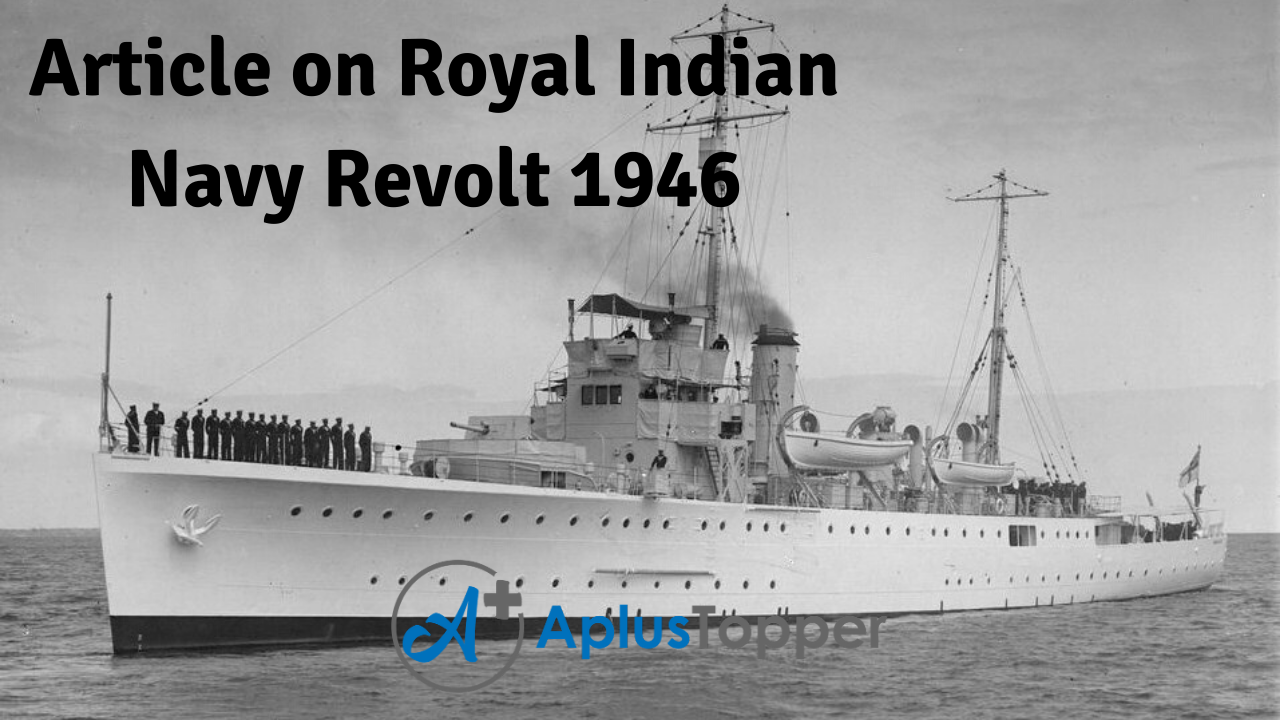Article on Royal Indian Navy Revolt 1946: The Royal Indian Navy revolt incorporated a total strike and further revolt by the Indian mariners of the Royal Indian Navy present onboard transport just as the shore foundations at Bombay harbour on 18 February 1946.
From the underlying flashpoint in Bombay, the revolt spread and discovered help all through British India, from Karachi to Calcutta, and at last, came to include more than 20,000 mariners in 78 ships and shore foundations. The uprising was stifled with power by British soldiers and Royal Navy warships. Just the Communist Party bolstered the strikers.
You can read more Article Writing about people, sports, technology many more.
Long And Short Articles On Royal Indian Navy Revolt 1946 for Students and Children in English
The Royal Indian Navy Revolt, 1946, was one of the most significant protests in the history of India’s Independence struggle. At times of competitions or examinations, the students can require help on this topic to write in their assignments or exams. The long Article on Royal Indian Navy Revolt 1946 are helpful for students of classes 7, 8, 9, and 10. Simultaneously, the short Article on Royal Indian Navy Revolt 1946 will be useful for students of classes 1, 2, 3, 4, 5, and 6.

Long Article On Royal Indian Navy Revolt 1946 500 Words in English
The Royal Indian Navy mutiny, 1946 was the most critical event in convincing the British government that it could no longer hold on any rule on India. The Royal Indian Navy revolt began on 18 February 1946 in Bombay. The maritime appraisals on HMIS Talwar challenged the low quality of food and racial separation by British officials.
The dissent spread quickly to the Castle and Fort encampment inland, and 22 boats in Bombay harbour. By the next night, a maritime focal strike board had been chosen. The rebels took out a parade in Bombay, holding high up a picture of Subhas Bose. Their boats additionally raised the banners of the Congress, Muslim League and Communist Party.
The requests progressed by the maritime focal strike advisory group joined assistance complaints with more great national concerns. The last incorporated arrival of INA (Indian National Army) workforce and other political detainees, withdrawal of Indian soldiers from Indonesia and the acknowledgement of Indian officials just as heads took place.
Evaluations in striking maritime foundations outside Bombay reverberated these topics. The strike spread to other maritime foundations around the nation. At its stature, 78 boats, 20 shore foundations, and 20,000 evaluations were engaged with the uprising. The revolt at different areas was facilitated by signal correspondence gear on board HMIS Talwar.
The most critical element of this short uprising was the enormous overflowing of open help for the double-crossers. The city of Bombay, particularly the working classes as well as the ordinary people, protested on 22 February in solidarity. The open vehicle organizes brought to an end, trains were scorched, detours were raised, and business foundations were closed down.
A military brigade was drafted to control the circumstance. After three days, Bombay was calm. However, 228 regular people had kicked the bucket, and 1,046 were harmed. In the interim, after affirmations of thoughtful treatment from Vallabhbhai Patel and M.A. Jinnah, the appraisals in Bombay gave up on 23 February.
The Congress’ position was condemned at the time by the Communist Party and later by radical students of history who contended that in 1946 India remained at the edge of a substantial mainstream uprising—one that could have made sure about us genuine autonomy rather than an unimportant “move of intensity”.
These contentions can be exaggerated, yet the reality remains that the RIN revolt persuaded the British that the blade arm of the Raj could never again be depended upon to ensure it. Something that these occasions have little bought on our authentic creative mind is a declaration to the proceeding movements with the grasp of patriot historiography in our comprehension of the 1940s.
In returning to these occasions, however, it additionally needs an arrangement in a more extensive, worldwide setting. For the RIN revolt resonated well past the subcontinent. On 19 February, the evaluations destroyed and consumed the American banner at the US Information Service office in Bombay. American knowledge depicted the revolt as “portrayed by unexampled brutality” and as a “bash of carnage and devastation”.
Short Article On Royal Indian Navy Revolt 1946 300 Words in English
The Royal Indian Navy revolt began on 18th February 1946, when 1100 mariners on the HMIS Talwar halted work and announced an official strike at daybreak. The mariners collectively chose signalman M.S Khan as President and frivolous official telegraphist Madan Singh as Vice-President.
Driving signaler Bedi Basant Singh, S.C. Sen Gupta, Chief Petty Officer, School Master Nawaz, Seaman Ashraf Khan, Able Stokers Gomez and Mohammad Hussain were likewise chosen for the Central Strike Committee.
The Central Strike Committee was clear about the idea of their battle for autonomy and financial increases which can be checked from their activity of dropping the ‘Illustrious’ prefix and considered themselves the ‘Indian National Navy’ (INN) following the strides of Bose and the INA.
They additionally drew up a sanction of requests requesting the arrival of all the political detainees, the withdrawal of Indian soldiers from Indonesia and Egypt, for guaranteed improvement in their conditions, and the arrangement of equivalent status with the British officials. The board of trustees amidst huge help and cheers got the contract acknowledged from their kindred mariners.
The naval force revolt didn’t occur without any forethought. The revolt occurred because of the amassing of disdain over an extensive stretch among the mariners. The pay of the British mariners was multiple times more than that of the Indian mariners. Also, British mariners would be advised to food, better quarters, and better quality outfits and voyaged easily in singular compartments.
The Indian military quarters were ‘pigsties’, the food was frequently unpalatable, and Indians were crowded into train compartments. Anyway, with the war arriving at end retirement and the uneasiness of joblessness was drifting over the mariners. In any case, the significant reason for the revolt was political, and the preliminary of the Indian National Army (INA) pioneers went about as pouring petroleum over the fire.

10 Lines On Royal Indian Navy Revolt 1946
- The strike began in Bombay harbour where an unforeseen of appraisals had shown up.
- The evaluations of HMIS Talwar, a shore foundation additionally had fuming discontent against their seniors for comparative reasons.
- The strikers were roused by the INA preliminaries and the persona of Subhas Chandra Bose.
- Before long, the strike advanced into open revolt with numerous urban communities joining the Bombay mariners.
- Mariners from Karachi, Calcutta, Poona, Vizag and Cochin joined including 66 ships and shore foundations.
- Evaluations were not complying with their officials, and they directed exhibitions in the city of Bombay leaving their posts.
- The city of Bombay especially was tense. Several protestors focused on the British occupants and officials of the city.
- They even assumed responsibility for Butcher Island where the full ammo of the Bombay Presidency was put away.
- The radicals likewise discovered help from the Royal Indian Air Force men from Bombay and from the Gurkhas in Karachi.
- The mariners showed a stable solidarity cutting across lines of religion and district despite the looming segment of the nation on public lines.
FAQ’s on Article on Royal Indian Navy Revolt 1946
Question 1.
What occurred in 1946 according to Royal Indian Navy?
Answer:
On February 18, 1946, an area of non-appointed officials and mariners known as Ratings, serving in the Royal Indian Navy, mutinied against the British Officers. The rebellion began as a strike by the evaluations to challenge the difficulties in regards to paying, food and racial separation.
Question 2.
On which of the accompanying armadas was the Naval Revolt 1946 begun?
Answer:
The Royal Indian Navy revolt included an all-out strike and resulting revolt by Indian mariners of the Royal Indian Navy onboard boat and shore foundations at Bombay harbour on February 18 1946.
Question 3.
What is meant by rating in the Navy?
Answer:
In a naval force, a rate, rating, or bluejacket is a lesser enrolled individual from that naval force who isn’t a warrant official or appointed official.
Question 4.
Who was appointed the first Indian chief of the naval staff after independence?
Answer:
In February 1958, Katari was designated as the first Indian Chief of the Naval Staff (CNS).
